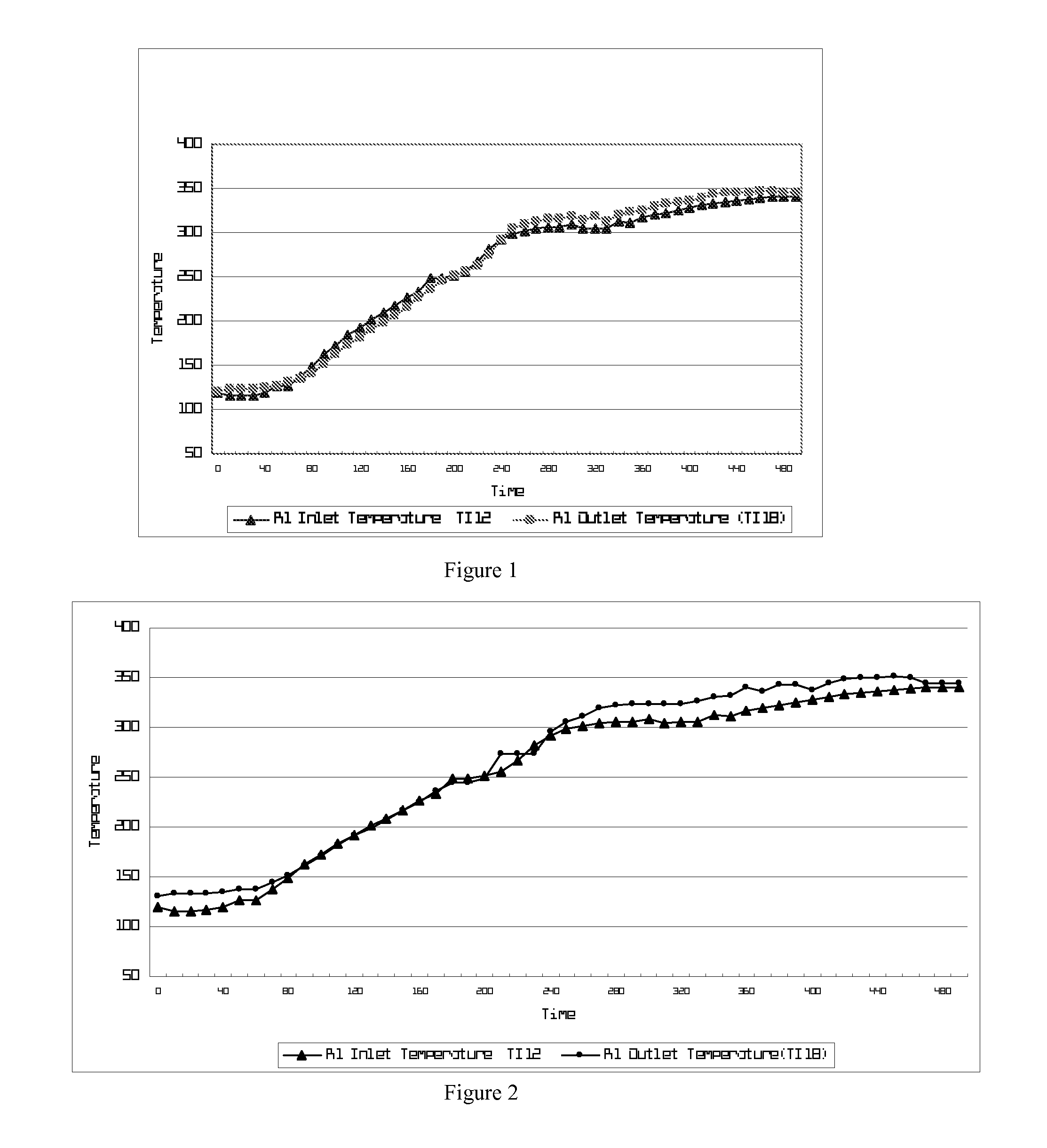Hydrogenation catalyst composition, process for preparing the same and use thereof
- Summary
- Abstract
- Description
- Claims
- Application Information
AI Technical Summary
Benefits of technology
Problems solved by technology
Method used
Image
Examples
example 1
[0040]The commercial hydrodesulfiding catalyst FH-5A (developed by Fushun Research Institute of Petroleum and Petrochemicals, and produced by Wenzhou Huahua Group Co.) was used, and the main components and properties can be found in Table 1.
[0041]The specific presulfurization comprises the steps of[0042]1. homogeneously impregnating triethylamine onto the catalyst FH-5A in oxidation state, wherein triethylamine is in an amount of 9% by weight of the catalyst, to form a catalyst supported with thiethylamine;[0043]2. dispersing the elemental sulfur in a solvent in which the volume ratio of catalytically cracked gasoline to rape-seed oil is 5:1, wherein the solvent is in an amount of 25% by weight of the catalyst, and the elemental sulfur is in an amount of 115% by weight of the sulfur-requiring amount calculated theoretically amount of the metal-containing catalyst; spraying the solvent, in which the elemental sulfur is dispersed, onto the catalyst supported with triethylamine in said...
example 2
[0045]The catalyst in oxidation state was the same as that in Example 1, i.e. FH-5A. The specific presulfurization comprises the steps of[0046]1. dissolving triethylamine and gluconic acid in a weight ratio of 5:1 in aqueous ammonia containing 10 wt % ammonia to obtain a solution, impregnating the catalyst in oxidation state with said solution, wherein said substances are in an amount of 7% by weight of the catalyst; drying at 120° C. for 5 h, to obtain a catalyst containing mixed organic additives;[0047]2. dispersing the elemental sulfur in a solvent in which the volume ratio of vacuum gas oil to peanut oil is 1:3, wherein the solvent is in an amount of 30% by weight of the catalyst, and the elemental sulfur is in an amount of 90% by weight of the sulfur-requiring amount calculated theoretically of the metal-containing catalyst; spraying the solvent, in which the elemental sulfur is dispersed, onto the catalyst in said step (1); and[0048]3. treating the catalyst obtained in said st...
example 3
[0050]The catalyst in oxidation state was the same as that in Example 1, i.e. FH-5A. The specific presulfurization comprises the steps of[0051]1. homogeneously impregnating the catalyst FH-5A in oxidation state into the aqueous solution of amino acetic acid (containing 4.0 wt % amino acetic acid), wherein the amino acetic acid is in an amount of 0.05% by weight of the catalyst; then drying at 110° C. for 4 h, evaporating water to obtain a catalyst supported with amino acetic acid;[0052]2. introducing the melted elemental sulfur into the catalyst containing amino acetic acid in step (1), wherein the elemental sulfur is in an amount of 105% by weight of the theoretical sulfur-requiring amount of the catalyst; then adding into the mixture in which butyl acetate, methyl phenylacetate and catalytically cracked diesel oil are in a weight ratio of 1:1:8, wherein the mixture is in an amount of 40% by weight of the catalyst; and[0053]3. treating the catalyst obtained in said step (2) at a no...
PUM
| Property | Measurement | Unit |
|---|---|---|
| Temperature | aaaaa | aaaaa |
| Temperature | aaaaa | aaaaa |
| Temperature | aaaaa | aaaaa |
Abstract
Description
Claims
Application Information
 Login to View More
Login to View More - R&D
- Intellectual Property
- Life Sciences
- Materials
- Tech Scout
- Unparalleled Data Quality
- Higher Quality Content
- 60% Fewer Hallucinations
Browse by: Latest US Patents, China's latest patents, Technical Efficacy Thesaurus, Application Domain, Technology Topic, Popular Technical Reports.
© 2025 PatSnap. All rights reserved.Legal|Privacy policy|Modern Slavery Act Transparency Statement|Sitemap|About US| Contact US: help@patsnap.com

